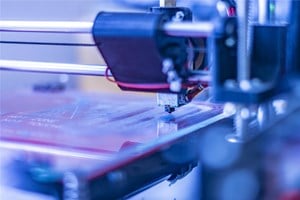
A Solid Bond: The Use of Sintering Furnaces in Additive Manufacturing
Posted on November 13, 2019 in Blog

THE RISE OF ADDITIVE MANUFACTURING
In recent years we have seen an explosion of additive manufacturing. It gets its name "additive" as you are adding material to create the part whereas with conventional methods, you are typically removing material from a block or ingot to achieve your desired end results by cutting and machining. 3D printing, pressing, or extruding are all forms of additive manufacturing.
Additive manufacturing allows for the creation of lighter, stronger parts and systems. The technology has a growing application area, and allows for low-cost, rapid product growth. These factors are driving the rise of additive manufacturing which shows no signs of slowing down. In fact, MarketWatch predicts the global additive manufacturing market will exceed 6.5 billion USD by 2024, and grow at a CAGR of more than 13 percent in that time.
Additive manufacturing is commonly found in the automotive industry and is used in the manufacturing of both transmission and engine parts. Many of these parts also require sintering in a heat treat furnace to bind pieces of the component together. With the rapid rate of new capabilities, the possibilities of additive manufacturing in the future seem endless.
THE HISTORY OF ADDITIVE MANUFACTURING
Additive manufacturing dates back to the 1800s, when François Willème created three-dimensional photosculptures by surrounding objects with a number of cameras. In 1892, Joseph E. Blanther proposed layering materials to create 3D topographical maps. In 1972, Matsubara of Mitsubishi Motors came up with an idea to create components by layering photopolymers, or light-activated resins that change their properties upon exposure to light, to create casting molds.
In 1983, Chuck Hull invented stereolithography (SLA or SL), a form of 3D printing that turns liquid photopolymer plastics into solids. The stereolithography process involves adding layers of liquid plastics then using ultraviolet (UV) rays to cure the photopolymers to create a hard, durable surface.
Just three years later, Carl Deckard and Joe Beaman at the University of Texas at Austin’s Department of Mechanical Engineering developed selective laser sintering (SLS), a 3D printing technique that uses high-powered lasers to fuse layers powdered materials to create components. In 1991, Stratasys produced a fused deposition modeling machine that used an extruder to deposit layers of plastic on a print bed.
THE USE OF SINTERING FURNACES IN ADDITIVE MANUFACTURING
Sintering is the process of heating compacted or printed components to form a solid mass of powdered materials without melting it to the point of liquefaction. When powdered material is sintered, it converts the printed or pressed powder into final parts. Sintered powder metallurgy makes it possible to bind parts that would be difficult, if not impossible, to bind with conventional manufacturing practices.
Sintering furnaces allow manufacturers to create robust component designs with much less labor and effort, which helps to reduce the overall manufacturing cost and time. Working with powdered metallurgy creates less scrap than conventional subtractive machining techniques.
Additive manufacturing utilizes sintering furnaces to bond parts or pieces of a product together at nearly every stage of manufacturing, from rapid prototyping to mass production. Some of the automotive transmission components manufactured with additive methods and sintering include synchronizer system parts, turbine hubs, gear shift components, planetary gear carriers, clutch hubs and pocket plates.
Lindberg/MPH manufactures sintering furnaces for additive manufacturing applications. These sintering furnaces are available in a variety of configurations and custom designed to meet the customer’s specific process requirements. For more information on the sintering process and Lindberg/MPH’s sintering furnaces visit our website http://www.lindbergmph.com or connect with us through our Facebook or LinkedIn pages.

